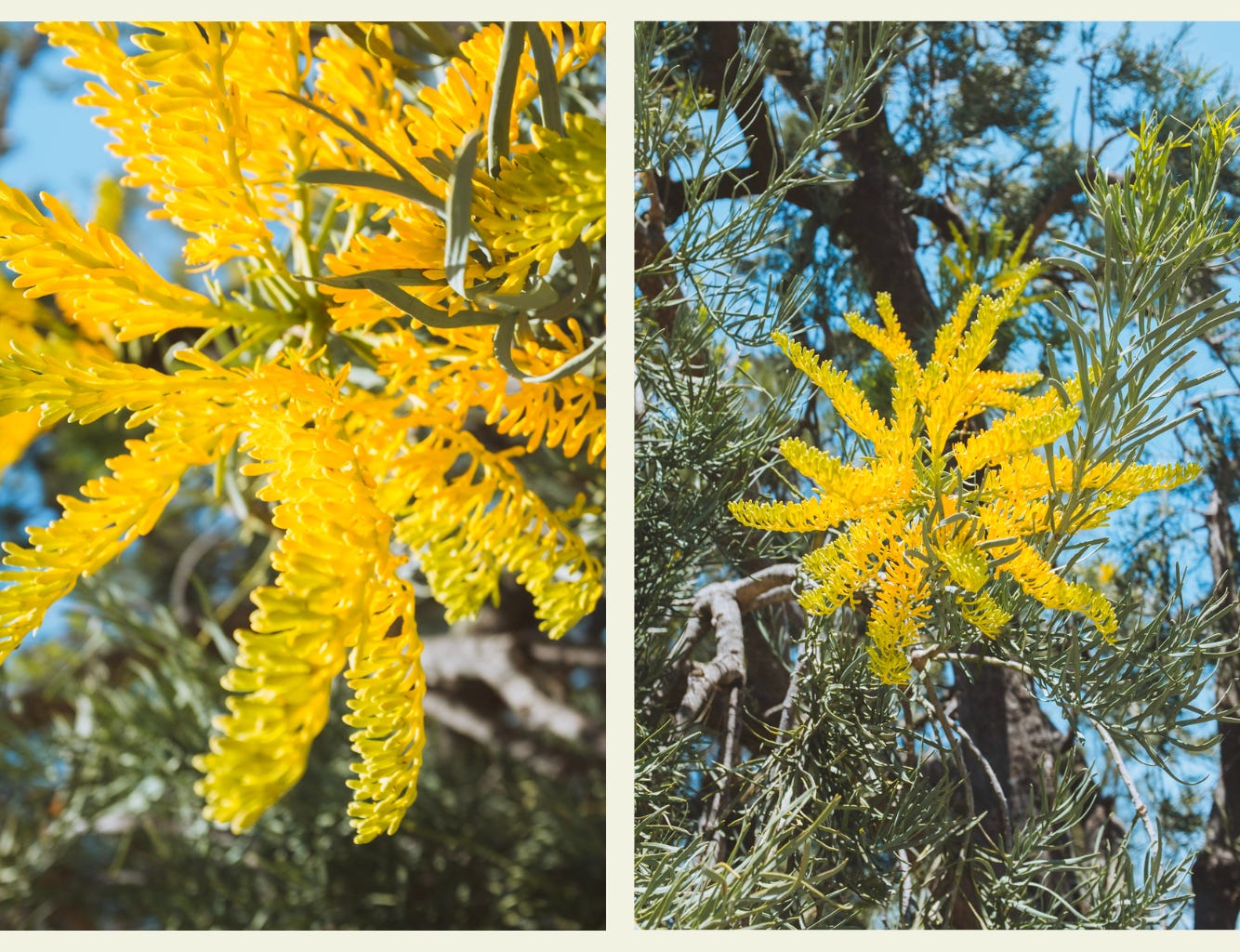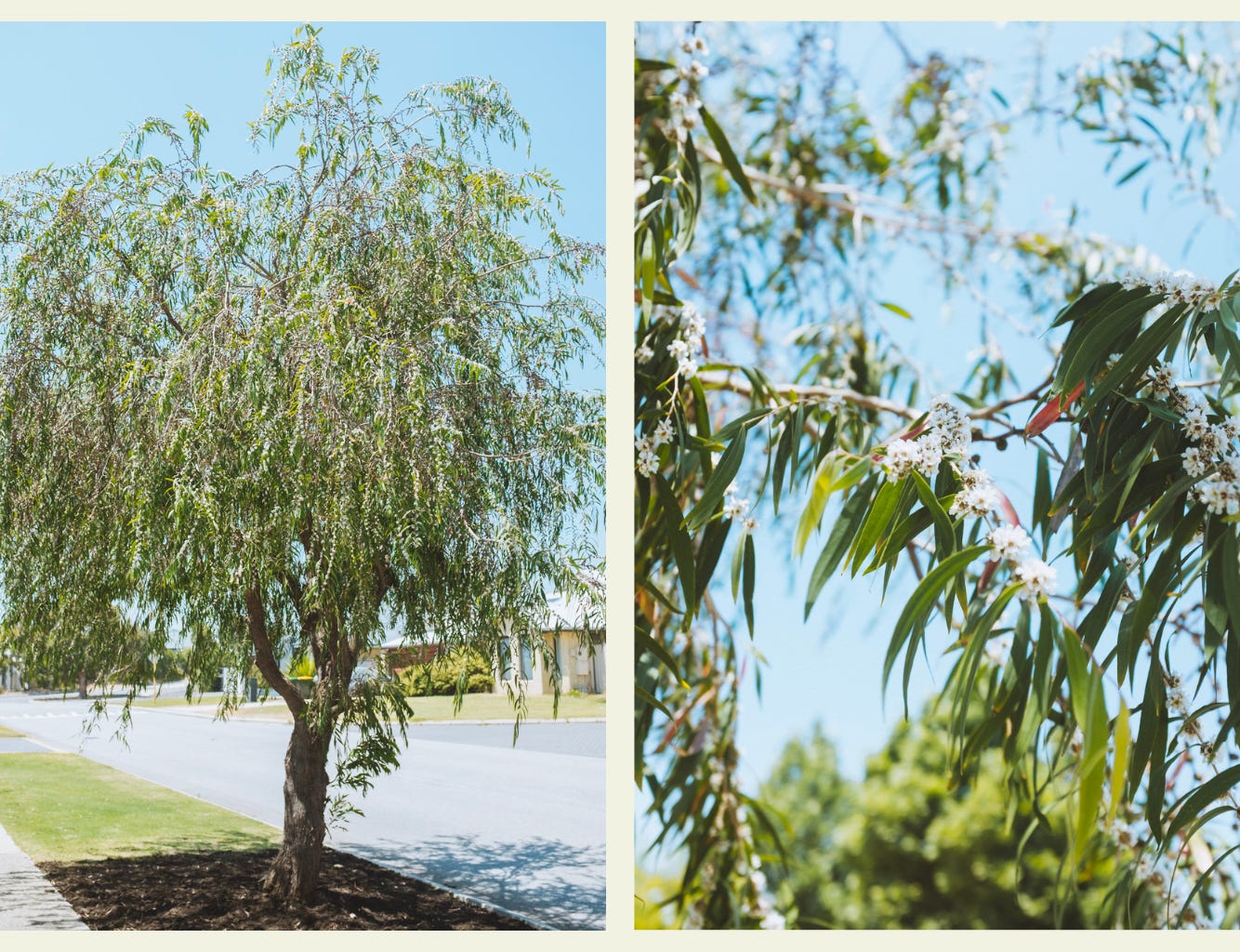Kambarang Things
Where I live it's the Noongar season of Kambarang, or the second spring. Things are warming up and colour abounds. I muse about five plant-happenings that are giving me a thrill.
In the Perth region, we are currently in the Noongar season of Kambarang, or the second spring, when things start to warm up, snakes become active, and many plants put on colourful faces. Traditionally, Kambarang was a sign for Noongar people to start moving towards the coast, letting the inland resources rejuvenate and relying on coastal resources. This is a list of plant-happenings that I’m noticing around my area and things that are giving me a thrill to see.
1. Moodja / WA Christmas Tree / Nuytsia Floribunda
Every year, when I first clap eyes on a flowering Moodja tree, my heart gets caught in my throat. It looks like an otherworldly vision, so bright and almost luminescent. You can always spot them from far away. Even if you’re flying down the freeway they ask for attention. The Moodja starts to bloom this time of year, and the bright orange blossoms continue through the season of Birak, or first summer. Moodja are a type of mistletoe, and the world’s largest parasitic tree. Under the surface of the earth, the Moodja will form a white ring around the roots of other plants in order to take water and nutrients for itself. For many Noongar groups, the Moodja are sacred trees, helping restless spirits find their way to the afterlife. The Moodja are teachers and guides, showing us how we should relate to Country and community. They can survive in a diverse range of habitats by drawing on the resources available. In this way, the Moodja shows us that we can thrive wherever we are, even in apparently dry and unlikely areas, by drawing on a range of resources without draining any one source.
2. Balga / Grass Tree / Xanthorrhoea Preissii
It’s the sun that first wakes up the flowers on the Balga. If you’re lucky to catch a Balga spear just starting to flower, you’ll see the flowers appear on the north side first. Eventually the creamy flowers open up along the full surface of the spear, which juts joyfully towards the sky. The spears are usually 1.5 to 2.5m long. Some are bowed and start to bend over, but most are proud and straight. I find the slow growth of the Balga trees encouraging. The trunks are made from old leaves that are flattened out and held together with resin. It’s a slow going creation, adding only about a couple of centimetres to the plant’s height per year. But the Balga isn’t afraid to take its time. It knows it’s destined to be an elder of the bush, living for hundreds of years. It also knows the art of enduring through fire, and blooms stronger on the other side, providing much needed sweet nutrients for birds and insects when most of the bush has been stripped bare.

3. Wattle / Acacia
About a month ago, a street I drive on regularly was lined with the fuzzy golden glow of wattle trees in bloom. In other parts of the year the trees are green and unassuming, but in early spring they command eyes. Look at me! Now the flowers have all finished their performance, and the trees are covered in long, crinkly seed pods. I like their texture and the sounds they make when I shake them or roll them about in my palms. They often have swirling, subtle colours. It’s not the demanding showiness of the blossoms, but the seed pods are beautiful in their own way. The ones near my parents’ place are just now cracking open and dropping their seeds everywhere. Wattles native to the Perth region such as Mindaleny (prickly Moses) and Cujong (orange wattle) have an important place in Noongar culture. The bark and wood were used for making spears and digging sticks, and the seeds provided a good source of fat and protein. The seeds would be roasted and eaten whole or ground down into a powder and then baked into damper.
4. Wanil / Peppermint Tree / Agonis Flexuosa
If I pass a peppermint tree while walking in the bush, I’ll pick a single leaf and crush it between my fingertips, then take deep inhales. The minty smells are calming and bring me back to my body. This time of year the Wanil trees are blooming with delicate white flowers. The branches droop low and sway sweetly, giving the tree a wispy, breezy sort of personality. The leaves were traditionally used by Noongar people as an antiseptic and decongestant. It’s a leaf for breathing well, and for healing. I stumbled across this recording of Noongar Elder Neville Collard talking about how peppermint was used to treat sick children. The branches were placed over a fire until the oils came out of the leaves, and then the oil was rubbed on the child’s chest or under their nose.
5. Biara / Candlestick Banksia / Banksia attenuata
Candlestick banksia is one of the most common banksia species in the Swan Coastal Plain, and a very important tree for our banksia woodland habitats. They also grow widely from Geraldton down to Esperance. The large, slender flower spikes are easy to spot, being such an obvious yellow colour. The birds love them for their sweet honey-like nectar, and in traditional Noongar culture, the nectar was a popular human snack too, sucked directly from the flower or made into a sweet drink. In some sources I’ve read, the base of the stem bud was chewed as an appetite suppressant when making long journeys. Like many species native to the South West of Australia, banksia attenuata grows best in sandy soils and can cope with long spells of dryness. Resilient, resplendent, and a favourite of mine.

I’m curious what things you’ve been noticing and admiring in your local area that are particularly to this time of the year. Let me know what’s been giving you a thrill to see.
Wishing you a colourful rest of November,
Melody
PS. A little note on Noongar names for plants… there are often many different names and many different spellings for each plant across different Noongar groups. Where possible I’ve used names that are somewhat widely known or familiar to me, but they are by no means the only names used. I think it’s important to acknowledge that. While I’m keen to learn Noongar plant names and use them in my daily life, I don’t want to oversimplify the amount of diversity and variation between Noongar language groups. Here are some handy resources I’ve been using to learn more about Noongar plant names: Anthropology from the Shed, this paper by Dr Ian Abbot, this list compiled by Perth NRM and Whadjuk Walking Trails.
All photos taken by me, 2023.








Loved these Kambarang things 🌿